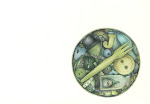Here's a post from the archives. It's from July 2010. The first thing that goes through my head is how things have changed! I would never use this method these days. My drawing is so much more instinctual now, but back then I was learning. I was teaching myself to draw. And, for me, that makes it a valid exercise, but then any sort of drawing that you do is valid. It's all about practice, and no matter how much we'd love magic pens the fact is that if you want to get to a place where you're confident enough to become instinctual you need to put the learning in first. And, what I have found also is that drawing is all about looking, seeing, and that is something else I was teaching myself to do here. Look. See.
The other thing that has changed is an obsession with drawing shoes - where did that come from??!Anyway, here's
How To Draw a Shoe by Andrea Joseph 2010
Over the past few years I have worked through many different processes, when drawing from still life, to get to the one that I am happy with. As I'm self taught it's been a process of elimination to find the ways that work best for me. I have narrowed it down to a couple of methods actually. I'll show you both in the next two posts, and demonstrate with my favourite subject matter; shoes.
Above are the tools I have used. They are; a cartridge paper sketch book; tracing paper; pencil; rubber (I believe that means something different in the US?!); three blue ballpoints; one red ballpoint. I want to stress at this point, because I'm asked so frequently, I use ANY kind of ballpoint pen. No special makes or brands. Any. As long as they aren't blotchy I'll use them.
Step 1. I am pretty obsessive about getting the shape 'right', so if I'm sketching something, for eaxmple an Adidas trainer, I will do the sketching stage on tracing paper. I realised, a while back, that I do not have any 'sketchy' books as such. I only ever produce finished drawings. I do, however, have huge amounts of roughs on tracing paper. Doing things this way means I can work on the shape I want to achieve and then transfer it easily to paper. It also means that, if I should want to, I can reproduce the same image (in different mediums). Which is something I do quite often.
Step 2. When I've got shape I want I transfer it to paper. In the image above you can see the ballpoint outline. I would obviously start with a pencil outline, but the scan I did for that was rubbish - you couldn't see anything. So when the pencil outline is put down on the paper, I go over it faintly with a ballpoint.
Step 3. I have started to add some shading (values?) to some areas. I work out where this shading should be by observing the shoe and where the shadows and light fall. Excuse me if all this sounds really patronising, it's not meant to. It's just how I have learnt to draw. Step by step.
Step 4. Here comes the cross hatching. This is the part where I feel I can really get into the zone with this drawing. I love this bit. The shoe is starting to come alive, and more texture is being added through the hatching.
Step 5. A continuation of the last step. More building, more hatching, more texture. Also at this point I'm starting to add the detail. That's another bit I love doing.
Step 6. The finishing touches. My most favourite bit. Details, a bit of extra hatching and a splash of red. In this drawing the final finishing touch was to outline the shoe with a bolder line, using a ballpoint that has a bigger nib.
And that's it!
That's how I did things back then. Actually, this is the way I'd work these days for an editorial or book illustration job or for something that needed planning and page layout. So, I learnt quite a lot from that period. Mostly, I learned about seeing. And, funnily enough, I went on to teach a Sketchbook Skool course of that very name ('Seeing') five or so years later.
More demonstrations and things from the archives all month, here, on my blog.
But for now, that's all folks!









1 comment:
Great to see your technique, I'm in awe!
Post a Comment